“Diversify to Grow” – Strade & Autostrade Talks About Us
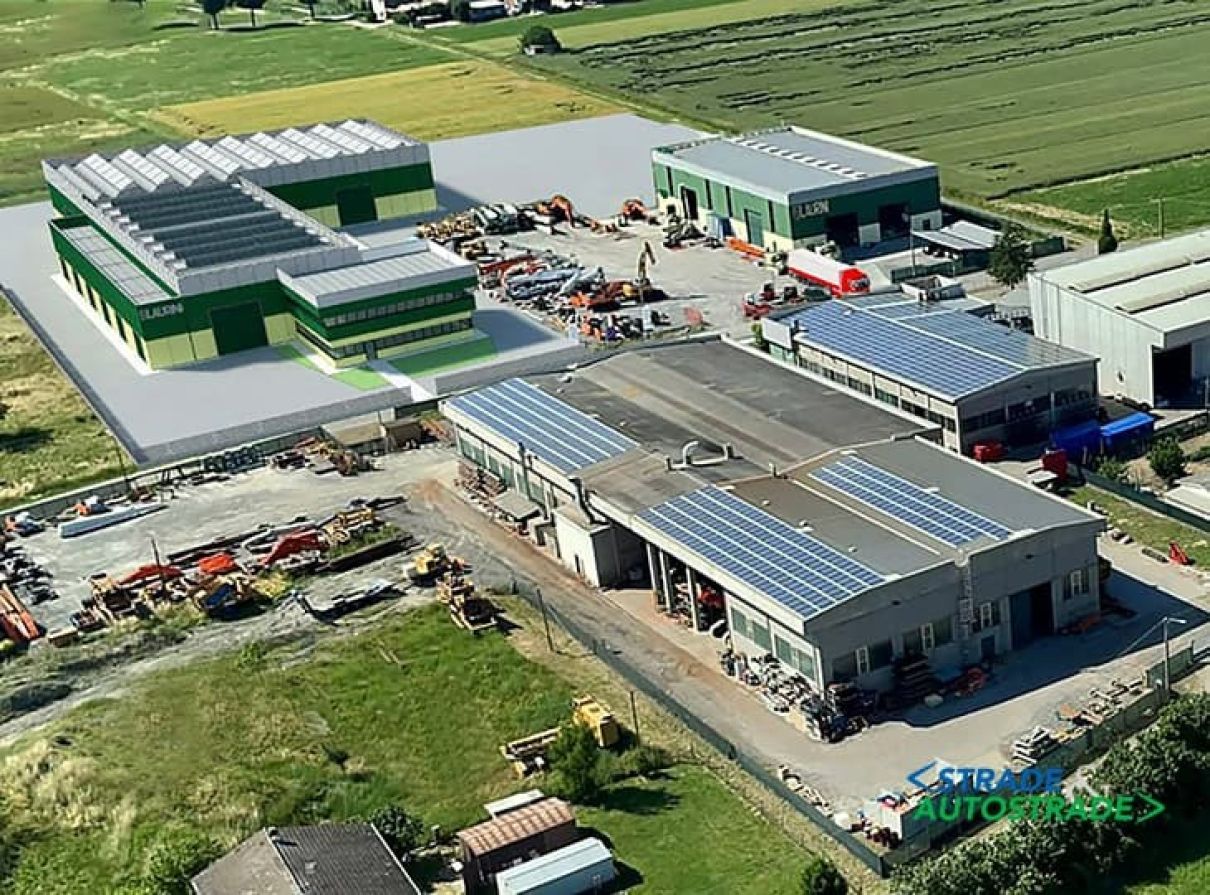
Laurini Officine Meccaniche is a relatively new name in the field of special machinery, even though it will celebrate its 70th anniversary in 2025. We met with Marco Laurini, who told us about the company’s journey and future prospects.
Authors: Giulio Novi, October 10, 2024
The world of construction machinery and equipment has long been dominated by historic names operating on a global scale, thanks to widespread distribution and service networks across the five continents. This is a well-established market landscape, although often subject to mergers and acquisitions that tend to reduce the number of key players on one hand, while increasing the size of the groups that continue to operate on the other. This situation inevitably pushes toward an economy of scale characterized by large numbers, leaving little room for new manufacturers, who would find themselves competing with highly structured multinational companies from both an industrial and commercial perspective. However, there is one area—special machinery—that presents interesting growth opportunities due to the increasing demand for targeted solutions that large groups are either unwilling or unable to provide.
Laurini is part of a group of small to medium-sized Italian companies that, thanks to their design capabilities and flexible production methods, can meet the needs of specialized companies seeking machinery suited to their clients’ specific applications. The unique aspect of Laurini is that, for decades, the company successfully operated in another sector before becoming a recognized name in the construction industry. We visited the headquarters in Busseto (PR), where Marco Laurini summarized 70 years of history and gave us an overview of the company’s current structure.
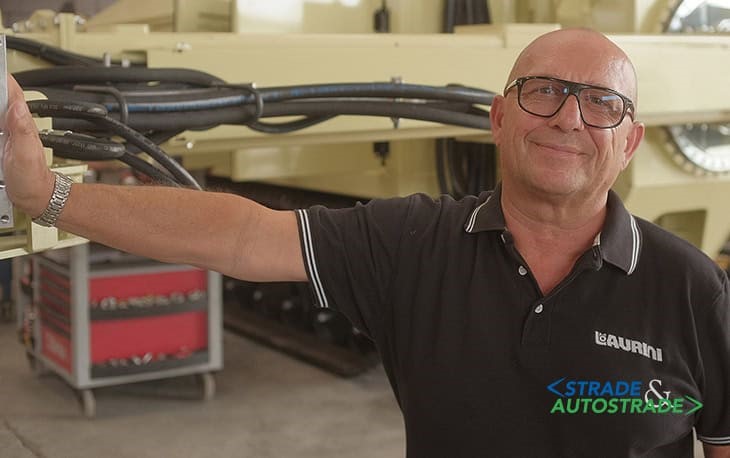
1. Marco Laurini, Sole Administrator of Laurini Officine Meccaniche Srl
How did you start the business?
Our story began back in 1955, when my father, Lodovico—then a mechanic responsible for maintaining machinery at a well-known button factory in the area—decided to start his own business and opened a small lathe shop for subcontracting work. We’re talking about a 50-square-meter space and a 27-year-old man with solid technical skills and a good dose of entrepreneurial spirit. In a short time, alongside producing special parts, he started repairing agricultural equipment and, eventually, some engines. Things were going well, and as the workload increased, in 1960, he moved into a 300-square-meter warehouse and hired a few employees.
How did your professional path begin?
As a young man, while I was still studying, I would sometimes spend time in the workshop. I enjoyed working on the lathe and learned how to use it well. In 1981, I joined the company full-time, but the turning point, if we can call it that, came in 1995 when I had a serious work accident and almost lost my left arm. I was forced to rest for over three months, during which I began designing a self-propelled, self-loading crusher for preparing gas pipeline bedding. We had clients in the oil sector, and I knew that what I had in mind would be a very interesting solution for them. After finishing the design and filing the patent, I estimated it would take 150 million lire to build the machine, which I called “Grub.”
I talked to my father about it, and he trusted me enough to lend me the capital, saying that if I believed in the project, I should make it a reality. The first unit was purchased by Bonatti, a company that used it on an overseas pipeline project. Soon after, a French contractor saw it at work and immediately ordered another one. However, the story didn’t end there. In 1997, we decided to create a website—a step that’s obvious today but was quite pioneering at the time, especially for a small company. That move proved to be another success, as an American company saw it online and ordered the third unit. From there, orders and contacts from all over Europe started pouring in. We went from a turnover of 300 million lire to three billion within two years. This success led me to design a mobile screen, which we named Vulcano. My father said I was a volcano of ideas, so we thought the name would bring good luck. Today, there are over 200 self-propelled Vulcano screens operating around the world.
How did you manage to reach these production volumes in a 300-square-meter warehouse?
It seems incredible. Imagine that there wasn’t even space for a paint booth, so we had to do it outside in a yard. Towards the end of the 1990s, though, we bought land and began building the headquarters where we are now, and in 2001, we moved here. It’s a 6,000-square-meter covered facility, soon to be expanded to 9,000, with 40,000 square meters of outdoor space.
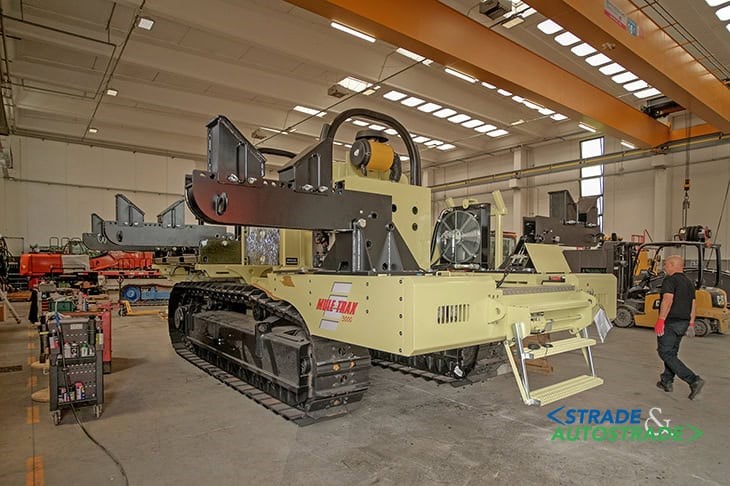
2. Today, Laurini continues to innovate in the Oil & Gas sector with new machinery
That first screen allowed you to enter the Oil & Gas sector. What are your thoughts on this field?
The Oil & Gas sector is definitely interesting because it offers good margins and significant visibility for manufacturers supplying equipment. However, it’s also marked by strong cyclicality due to fluctuating oil and gas prices. It’s always been this way, but in the last decade, the fluctuations have become much more pronounced, affecting companies of all sizes connected to the sector. For large oil companies, these swings usually result in stock value losses that are eventually absorbed, but for suppliers, it means frozen orders, excessive financial exposure, and the inability to plan production rationally. Conversely, when oil prices rise again, work speeds up, and deadlines become difficult to manage. This is why we began diversifying into the construction sector when the opportunity arose.
How did this opportunity come about?
In the early 2000s, a few companies asked us to modify excavators for demolition work. From those initial projects came more orders, and our name began circulating in the industry. In 2018, Doosan Europe contacted us to supply 24 machines per year, followed by Hitachi and other manufacturers who recognized us as a quality supplier. Over the years, we’ve gained not only a good reputation but also significant experience in designing and modifying machines. These projects, especially involving long booms and extendable undercarriages, which we produce, require high precision and quality during assembly. Although we will continue to adapt excavators for the brands we collaborate with, we’ve decided to develop a machine specifically designed for demolition, entirely of our own manufacture.
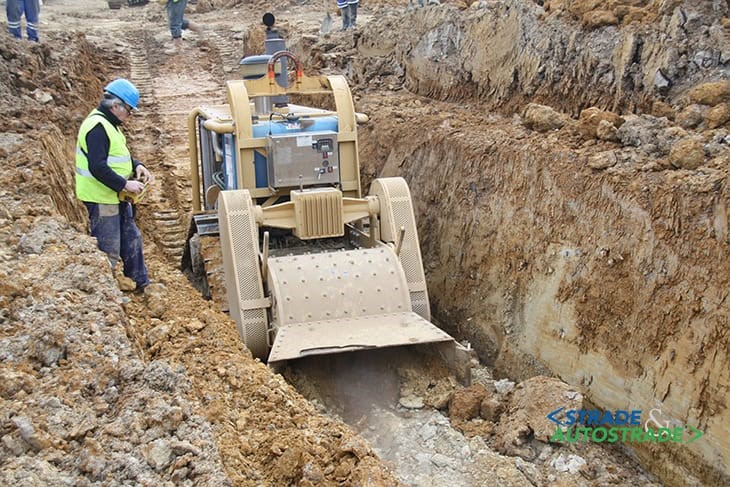
3. The Grub self-propelled, self-loading crusher speeds up and improves the efficiency of pipeline construction
What motivated you in this direction?
Several technical considerations, as well as production timeframes. One important aspect is the weight and dimensions. Our machine, called Settanta, which will be ready in 2025 for our 70th anniversary, has a boom pivoted at the rear of the turret and an engine placed laterally in a longitudinal position. This architecture has significant construction and operational advantages, as it doesn’t require counterweights for booms up to 24.5 meters. This feature, combined with an extendable undercarriage, makes transportation easier and offers logistical benefits by reducing setup times when the machine is delivered to a job site. The construction advantages are also significant because, unlike conversions, there is no need to modify the hydraulics, electronics, cab, or other parts. We design and install components specifically to meet the machine’s operational needs, compressing assembly and delivery times.
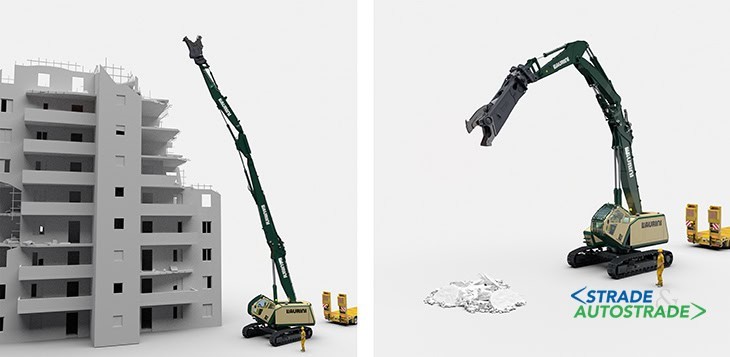
4. The Settanta machine is designed specifically for demolition, with the first units available in 2025
What do you think the market response will be?
Judging by the fact that we’ve already received three orders before producing the first unit, I’d say the concept of a machine dedicated to demolition has been well-received. However, I believe the potential success should be viewed more broadly. The need for machines designed for specific applications is something many users seek, but large manufacturers are not interested in addressing for obvious reasons. However, the demand exists, and I believe there are interesting opportunities for growth. These special machines and equipment won’t bring the large production volumes of mass-produced items, but they offer appealing volumes for a company of our size. That said, entering this market isn’t easy. To ensure the necessary quality, you need a high level of industrialization, combined with flexibility to meet users’ demands. Simplifying, one could say it’s like a tailor making custom suits but structured to serve multiple clients at once.
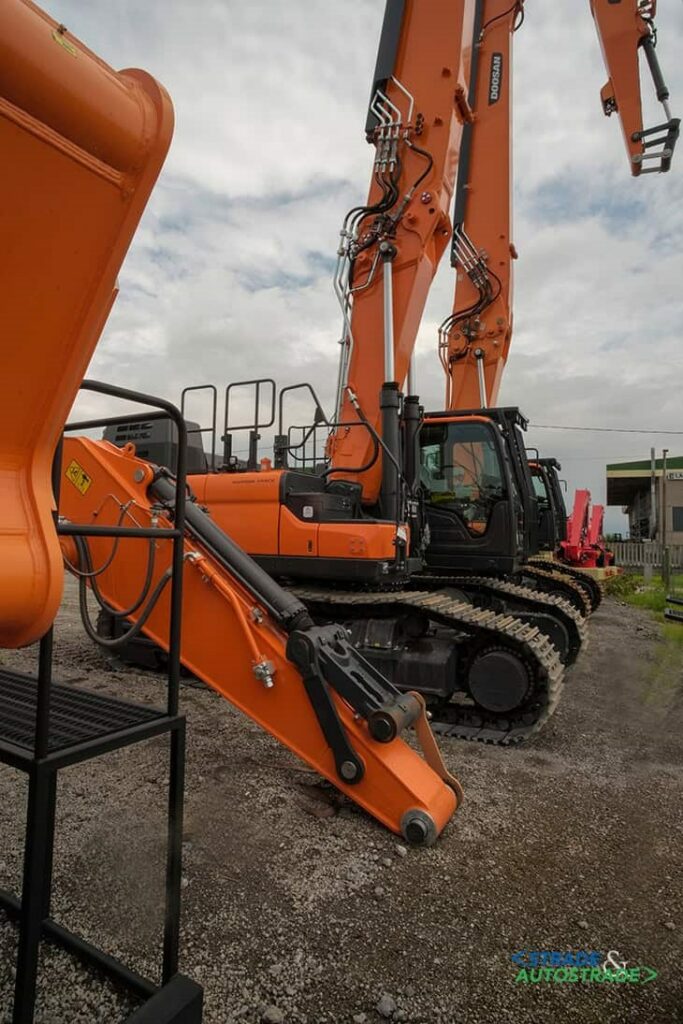
5. The company continues its transformation of series production excavators for the demolition sector
What other special machines have you developed?
In response to a request from Mosconi—a leading European company in hydrodemolition—we’ve been producing machines capable of scraping tunnel linings using a rotating telescopic arm for years. More recently, we’ve brought this technology into mechanical scraping. In this case, Amplia, seeking a system capable of milling an entire tunnel profile in a single pass, from wall to wall, approached us. We created the Joker system, of which one unit is already in operation, with two more to be ready by the end of the year. This is another innovative machine, born from our experience in hydrodemolition, and it’s unique worldwide. To make it even more efficient and equip it with an automatic arm control system, the next units will feature an automatic control system designed and patented by Grotti, a company that has been producing special scraping machinery for years. Although different in concept from the Joker, Grotti’s GTF series machines are considered the pinnacle of this application due to their power, reliability, and ability to perform multiple scraping tasks.
Have you therefore entered into an agreement with an existing manufacturer?
Yes, and we have done so by respecting each other’s specificities. We both understood that competition wouldn’t benefit us, which is why this agreement eventually led to another. Based on Grotti’s design and patent, we will develop a continuous dust and debris extraction system from the scraping process. We believe their experience in mechanical scraping systems and our production capabilities will lead to good results.
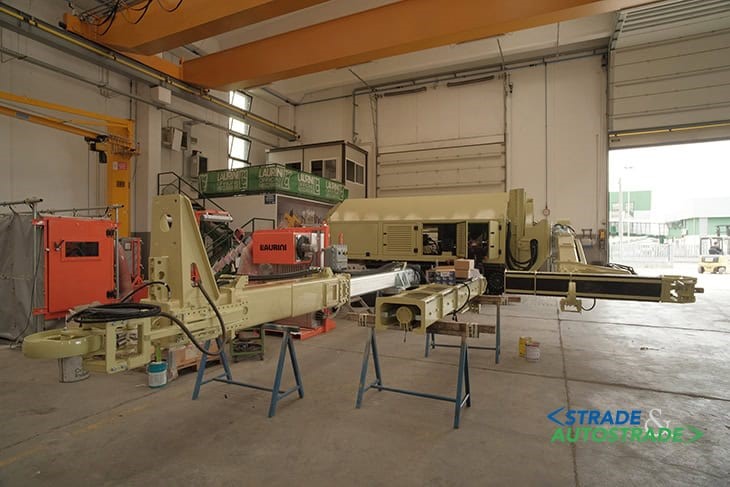
6. Laurini has been producing special machines for hydrodemolition for years. Here, a telescopic arm system is being assembled
This is a fairly innovative way of operating for a medium-sized Italian company. In Italy, such agreements are rare.
You’re right. If there were more of these partnerships, Italian companies might be better positioned in international markets and have more resources for research and development, which is the key to innovating and staying ahead of market demands rather than chasing them. In Grotti’s case, we could have continued on our own to develop our own automatic control system. Instead, we chose to leverage their expertise and acquire the license through a targeted agreement. I firmly believe in these types of collaborations. It’s not about merging companies or making acquisitions, but about building agreements and creating networks.
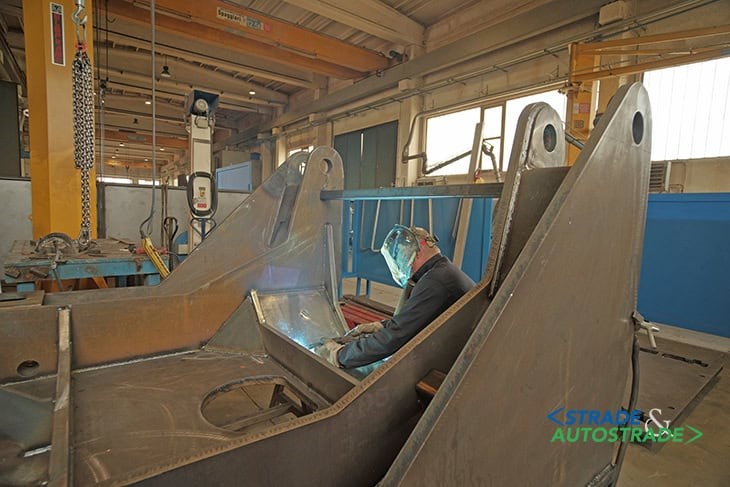
7. All metalworking, as well as the complete assembly of machinery, including electrical and hydraulic systems, is done at the Laurini plant
In conclusion, it seems that you now operate in various sectors and have managed to diversify while maintaining your distinct identity.
Absolutely. We are present in the gas pipeline installation sector, demolition, tunnel lining scraping, pipe driving, and the design of special machinery and equipment, even for third parties. As you’ve probably gathered, we’ve built this diversification in a relatively short time, but it hasn’t been an easy or risk-free journey. To achieve this milestone, credit must also go to our team: without their skills and dedication, it wouldn’t have been possible. Diversifying also means acquiring new knowledge, venturing into unexplored markets, and facing often complex technological and commercial challenges. In a market dominated by giants, it would be foolish to compete on their playing field. Instead, we must bet on our ability to innovate. After all, taking on challenges and having a vision for the future is part of the entrepreneur’s job, wouldn’t you agree?
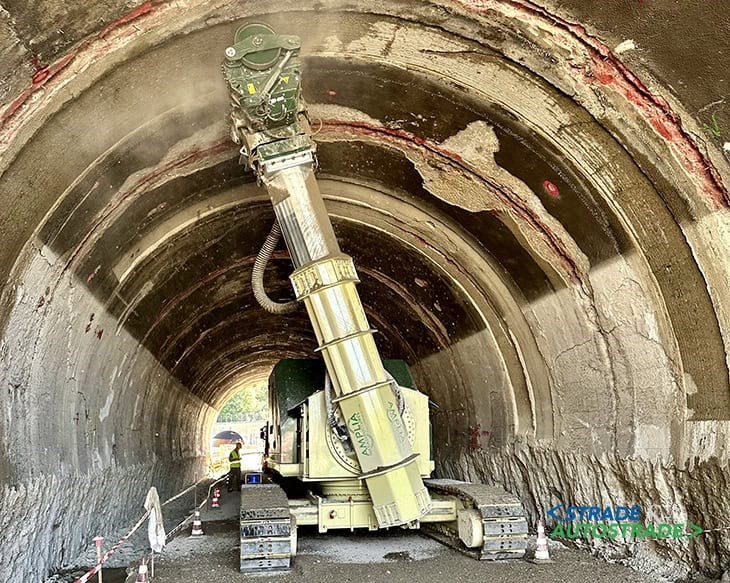
8. Joker is an innovative machine capable of scraping tunnel profiles in a single pass